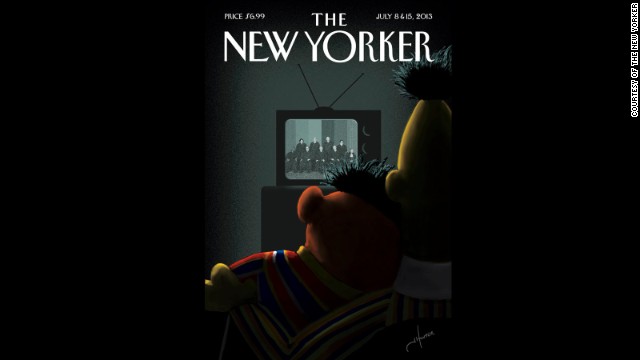
I saw this on my FB feed this morning. I know it's a bit of a fun thing for us adults to talk about, but it seriously got me to thinking: "How would Sesame Street handle an openly gay character?" Some advocate a Bert and Ernie wedding. I don't know if that would work for our target audience. It's not that it's inappropriate -- I'm sure there is an ever-increasing number of kids in the 2-7 age range that are now involved with same-sex marriage ceremonies. But for that kid who's not yet encountered a gay person: how do you introduce that via TV?
Sesame Street has always catered to kids; the South African/Nigerian Sesame Street created their HIV-positive character Kami because there are many children now born with HIV in that region or, as in her own case, that receive contaminated blood transfusions. Kami is also an AIDS orphan. There was no effort to make a huge social commentary about drug use, sex crimes, health programs, or other adult issues -- it's a kids show, and the point is that these kids will meet someone like Kami in their life, and they should not be afraid of her. Kami is a little girl who gets very lonely and sad sometimes -- she needs friends. Some adults threw a temper tantrum over her existence, but Kami and others like her are facts of life in that region.
In the US in 2011, Lily, the Food Insecure Muppet, was introduced. 17 million American children go hungry every day - she's one of them. There is no commentary about Lily's parents being deadbeats or what US department or program has failed her. The fact of the matter is, her family is poor and she's very hungry. All the time. She's very shy and more than a little ashamed that she is always hungry, just like those 17 million other kids. I'm very sad we haven't seen Lily again after that episode -- unlike Kami, who became a regular on SA/Nigerian Sesame Street.
Kids understand "hungry" from birth -- ask any new mother. Some know what it's like to lose a parent at a young age or to be constantly sick. Sexuality, however, isn't something that kids confront head on -- they understand the physiological difference between boys and girls, but not the birds and the bees or even the concept of having a crush (remember, we're talking about 2-7 year olds). In middle school, kids will have openly gay friends, just as they will have openly heterosexual friends. That's past Sesame Street's target audience.
A theoretical Bert and Ernie gay wedding announcement is suitable for that older audience and for us adults looking back and remarking, "Well that explains everything." But does that serve the average 5 or 6-year-old? Kids age 2-7 are pretty gender ambiguous - boys play dress up, girls play with trucks, and nobody minds. They aren't in romantic relationships. There is no concept of being "out." Some people have said that they "knew" from a young age that they were gay, but how does one express that through the television for someone as young as 2?
The sexuality of kids and how early you can declare them one orientation or another has been and will be debated. How many 2-7 year olds have the confidence and understanding to say "I'm gay"? Not many. What is more accessible and more common than that? How would Sesame Street depict being gay as more than just tokenism or, even worse, going through every bad stereotype?
To introduce gay marriage or gay identity on Sesame Street, gay parents probably offer the better way to go, Muppet or human. A kid doesn't see his/her schoolmates' parents everyday, but they are present. Kids have a remarkable sense of continuity from day to day IRL and episode to episode on TV. "Oh, that's Teddy, he has two dads." Teddy's two dads don't have to appear all the time on Sesame Street to have impact. The show doesn't go into the nuts and bolts of the relationship -- all that matters is that these people are here to love and care for that child. Just as Kami's story does not go into grown-up stuff, it still shows the impact of societal change on a young child. Kami has no parents and deals with health issues -- just like someone your child knows at school. Meanwhile, newly legalized gay marriages now enable people to adopt in several states -- someone will have a happy new home and a new life because of this positive societal change. If Sesame Street ever addresses gay marriage in their show, I think this may be their tact...if ever.
Sadly, when Kami premiered on SA/Nigerian television in 2002, Republican congressmen Billy Tauzin, Chip Pickering, Fred Upton, Joe Barton, Richard Burr and Cliff Stearns united to threaten PBS's funding if they dared to introduce a similar character in the US. Other conservative groups protested the very thought of adding such a character, insisting that if the character had HIV, it had to be gay (continuing to foster the ugly lie that only gays carry the dreaded disease). The US has never done a study to count how many AIDS orphans it has. Additionally, we never saw Lily again in the US after her one-hour special in 2011. A gay character -- Muppet or otherwise -- will appear on Sesame Street one day. However, it won't be in the US.
At least, not until Kami and Lily get their time in the sun here too.
*******
TIME magazine came out with the following article in anticipation of Lily's arrival. There's a super cute video with Kami and Bill Clinton in it as well, plus some insight on the origins of Bert and Ernie.
http://www.time.com/time/specials/packages/article/0,28804,2096216_2096217_2096235,00.html